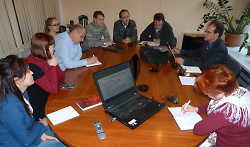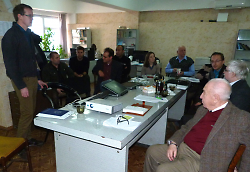Discussion of concept for "Water Use Efficiency Monitor for Central Asia"
During the first week of February 2015, CAWa scientists from the Remote Sensing Department of Wuerzburg University visited SIC ICWC in Tashkent and CAREC in Almaty to discuss the concept for a web-based application “Water Use Efficiency Monitor for Central Asia” (WUEMoCA). The application is the focus of CAWa work package 3 during the 3rd phase of the CAWa project in 2015-2017.
The meetings in Tashkent and in Almaty focused on specifications for the new web-based application “Water Use Efficiency Monitor for Central Asia” (WUEMoCA). The scientists from Wuerzburg University presented first concepts and learned about user demands on the new tool, which is planned to be developed in the third phase of the CAWa project “Water in Central Asia”.
WUEMoCA I: Early warning of harvest shortfalls

WUEMoCA is the major topic of WP3 in CAWa phase III (2015-2017). It focuses on the provision of an online tool for regional assessments of water use efficiency in all extensive downstream irrigation systems of the transboundary Aral Sea Basin. The first aim is to provide information about crop yields of the major crops, i.e. cotton, rice, and wheat, based on free-of-charge accessible remote sensing (MODIS 250 m) and meteorological data aggregated at different scales ranging from districts (rayons) to irrigation planning zones, and provinces (oblasts). This monitoring application can be used as an early warning tool for the localization of agricultural droughts and the prognosis of harvest shortfalls.
WUEMoCA II: Estimation of water use efficiency

Complementary to the monitoring application, the WUEMoCA tool will encourage user interaction. Thus, users will be allowed to add data on additional crops and on irrigation water amounts. This data can be used to calculate the water use efficiency, i.e. how much water was used for crop production m3/t. The user will be enabled to define a specific area of interest, for which efficiency indicators can be calculated. The second step should trigger user participation and raise interest in the development of own digital data management tools among the project partners and users.
Submitted by Katy Unger-Shayesteh on